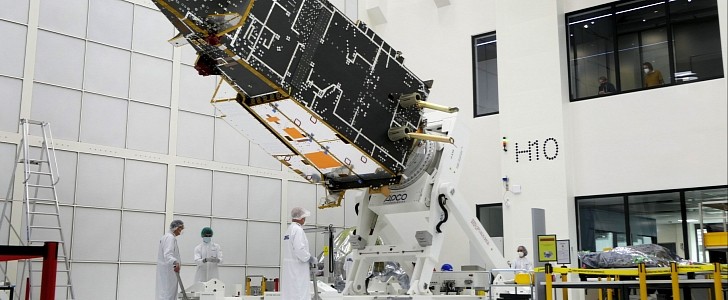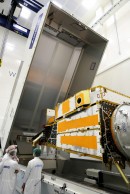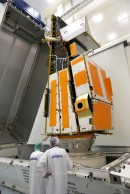Meteorological satellites are rarely in the spotlight and that’s a shame, because they are fascinating in their own way and they have an important mission, like this future forecaster that’s being built by Airbus.
The European Space Agency (ESA) and the European Organization for the Exploitation of Meteorological Satellites (EUMETSAT) are developing a series of innovative Meteorological Operational Satellites (MetOps) that will be providing data for weather forecast and climate monitoring, from the polar orbit, for the next 20 years.
The MetOp Second Generation (MetOp-SG) program consists of 2 series of satellites, with 3 units each, adding up to a fleet of 6 satellites. The Satellite A series will carry optical instruments and atmospheric sounders, while the Satellite B series will be dedicated to microwave instruments. Both of them are being built by Airbus, the first series in Toulouse (France), and the Satellite B series at the Friedrichshafen site in Germany.
At this moment, Airbus is working on the first MetOp SG-B weather satellite, after the giant satellite structure has arrived to the satellite integration center in Friedrichshafen. This structure is 19 ft. (6 meters) tall, 9 ft. (3 meters) wide and weighs about a ton. But this intricate-looking component is only the backbone of the future satellite, which will have a launch mass of around 4 tons.
Towards the end of next year, the satellite should be ready for the testing phase, when it will operate in space-like conditions.
Some of the things that these second-generation weather satellites will be able to provide include high-resolution measurements for the ocean surface, wind vector and soil moisture, as well as high-level precipitation and cloud measurements. The complex data these satellites will provide is obtained through optimized infrared, microwave, and radio-occultation instruments.
The first MetOp-SG satellite will be launched at the beginning of 2024. A pair of A and B polar-orbiting satellites will be constantly operating for the following 21 years, with each satellite being replaced with a new one every 7 years, when its service life ends.
The MetOp Second Generation (MetOp-SG) program consists of 2 series of satellites, with 3 units each, adding up to a fleet of 6 satellites. The Satellite A series will carry optical instruments and atmospheric sounders, while the Satellite B series will be dedicated to microwave instruments. Both of them are being built by Airbus, the first series in Toulouse (France), and the Satellite B series at the Friedrichshafen site in Germany.
At this moment, Airbus is working on the first MetOp SG-B weather satellite, after the giant satellite structure has arrived to the satellite integration center in Friedrichshafen. This structure is 19 ft. (6 meters) tall, 9 ft. (3 meters) wide and weighs about a ton. But this intricate-looking component is only the backbone of the future satellite, which will have a launch mass of around 4 tons.
Towards the end of next year, the satellite should be ready for the testing phase, when it will operate in space-like conditions.
Some of the things that these second-generation weather satellites will be able to provide include high-resolution measurements for the ocean surface, wind vector and soil moisture, as well as high-level precipitation and cloud measurements. The complex data these satellites will provide is obtained through optimized infrared, microwave, and radio-occultation instruments.
The first MetOp-SG satellite will be launched at the beginning of 2024. A pair of A and B polar-orbiting satellites will be constantly operating for the following 21 years, with each satellite being replaced with a new one every 7 years, when its service life ends.





